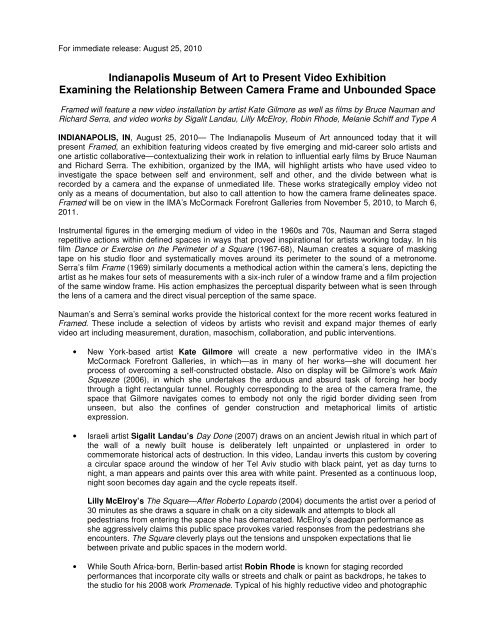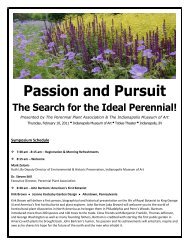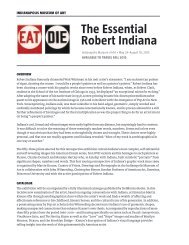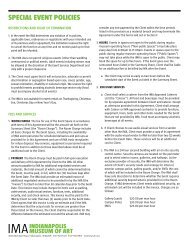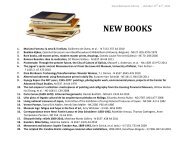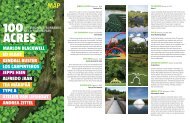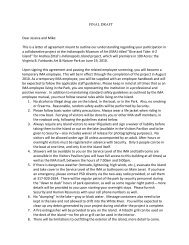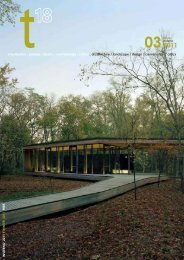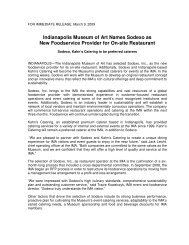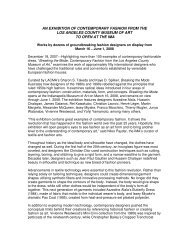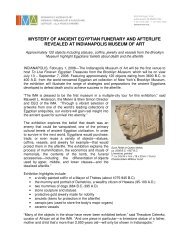Indianapolis Museum of Art to Present Video Exhibition Examining ...
Indianapolis Museum of Art to Present Video Exhibition Examining ...
Indianapolis Museum of Art to Present Video Exhibition Examining ...
You also want an ePaper? Increase the reach of your titles
YUMPU automatically turns print PDFs into web optimized ePapers that Google loves.
For immediate release: August 25, 2010<br />
<strong>Indianapolis</strong> <strong>Museum</strong> <strong>of</strong> <strong>Art</strong> <strong>to</strong> <strong>Present</strong> <strong>Video</strong> <strong>Exhibition</strong><br />
<strong>Examining</strong> the Relationship Between Camera Frame and Unbounded Space<br />
Framed will feature a new video installation by artist Kate Gilmore as well as films by Bruce Nauman and<br />
Richard Serra, and video works by Sigalit Landau, Lilly McElroy, Robin Rhode, Melanie Schiff and Type A<br />
INDIANAPOLIS, IN, August 25, 2010— The <strong>Indianapolis</strong> <strong>Museum</strong> <strong>of</strong> <strong>Art</strong> announced <strong>to</strong>day that it will<br />
present Framed, an exhibition featuring videos created by five emerging and mid-career solo artists and<br />
one artistic collaborative—contextualizing their work in relation <strong>to</strong> influential early films by Bruce Nauman<br />
and Richard Serra. The exhibition, organized by the IMA, will highlight artists who have used video <strong>to</strong><br />
investigate the space between self and environment, self and other, and the divide between what is<br />
recorded by a camera and the expanse <strong>of</strong> unmediated life. These works strategically employ video not<br />
only as a means <strong>of</strong> documentation, but also <strong>to</strong> call attention <strong>to</strong> how the camera frame delineates space.<br />
Framed will be on view in the IMA’s McCormack Forefront Galleries from November 5, 2010, <strong>to</strong> March 6,<br />
2011.<br />
Instrumental figures in the emerging medium <strong>of</strong> video in the 1960s and 70s, Nauman and Serra staged<br />
repetitive actions within defined spaces in ways that proved inspirational for artists working <strong>to</strong>day. In his<br />
film Dance or Exercise on the Perimeter <strong>of</strong> a Square (1967-68), Nauman creates a square <strong>of</strong> masking<br />
tape on his studio floor and systematically moves around its perimeter <strong>to</strong> the sound <strong>of</strong> a metronome.<br />
Serra’s film Frame (1969) similarly documents a methodical action within the camera’s lens, depicting the<br />
artist as he makes four sets <strong>of</strong> measurements with a six-inch ruler <strong>of</strong> a window frame and a film projection<br />
<strong>of</strong> the same window frame. His action emphasizes the perceptual disparity between what is seen through<br />
the lens <strong>of</strong> a camera and the direct visual perception <strong>of</strong> the same space.<br />
Nauman’s and Serra’s seminal works provide the his<strong>to</strong>rical context for the more recent works featured in<br />
Framed. These include a selection <strong>of</strong> videos by artists who revisit and expand major themes <strong>of</strong> early<br />
video art including measurement, duration, masochism, collaboration, and public interventions.<br />
• New York-based artist Kate Gilmore will create a new performative video in the IMA’s<br />
McCormack Forefront Galleries, in which—as in many <strong>of</strong> her works—she will document her<br />
process <strong>of</strong> overcoming a self-constructed obstacle. Also on display will be Gilmore’s work Main<br />
Squeeze (2006), in which she undertakes the arduous and absurd task <strong>of</strong> forcing her body<br />
through a tight rectangular tunnel. Roughly corresponding <strong>to</strong> the area <strong>of</strong> the camera frame, the<br />
space that Gilmore navigates comes <strong>to</strong> embody not only the rigid border dividing seen from<br />
unseen, but also the confines <strong>of</strong> gender construction and metaphorical limits <strong>of</strong> artistic<br />
expression.<br />
• Israeli artist Sigalit Landau’s Day Done (2007) draws on an ancient Jewish ritual in which part <strong>of</strong><br />
the wall <strong>of</strong> a newly built house is deliberately left unpainted or unplastered in order <strong>to</strong><br />
commemorate his<strong>to</strong>rical acts <strong>of</strong> destruction. In this video, Landau inverts this cus<strong>to</strong>m by covering<br />
a circular space around the window <strong>of</strong> her Tel Aviv studio with black paint, yet as day turns <strong>to</strong><br />
night, a man appears and paints over this area with white paint. <strong>Present</strong>ed as a continuous loop,<br />
night soon becomes day again and the cycle repeats itself.<br />
Lilly McElroy’s The Square—After Rober<strong>to</strong> Lopardo (2004) documents the artist over a period <strong>of</strong><br />
30 minutes as she draws a square in chalk on a city sidewalk and attempts <strong>to</strong> block all<br />
pedestrians from entering the space she has demarcated. McElroy’s deadpan performance as<br />
she aggressively claims this public space provokes varied responses from the pedestrians she<br />
encounters. The Square cleverly plays out the tensions and unspoken expectations that lie<br />
between private and public spaces in the modern world.<br />
• While South Africa-born, Berlin-based artist Robin Rhode is known for staging recorded<br />
performances that incorporate city walls or streets and chalk or paint as backdrops, he takes <strong>to</strong><br />
the studio for his 2008 work Promenade. Typical <strong>of</strong> his highly reductive video and pho<strong>to</strong>graphic
works, Rhode interacts with lines and shapes he has drawn on the wall <strong>of</strong> his studio. In<br />
Promenade, Rhode conjures up a series <strong>of</strong> chalk diamonds that eventually dominate the wall and<br />
engulf the artist before he is able <strong>to</strong> wrest back control <strong>of</strong> his creation and reclaim the defined<br />
space <strong>of</strong> the studio wall.<br />
• In Perfect Square (2006), Melanie Schiff sets up an underwater camera <strong>to</strong> record her quiet,<br />
poetic movements as she tries <strong>to</strong> swim, unsuccessfully, in a perfect square within the frame <strong>of</strong> the<br />
camera. Schiff’s ground is an emerald green pool <strong>of</strong> water that not only serves as a container for<br />
her body, but also as a mirror for the moving clouds and piercing sun above. The imprecise<br />
shape <strong>of</strong> Schiff’s route through the water contrasts sharply with the definite border <strong>of</strong> the<br />
camera’s frame, calling attention <strong>to</strong> the discrepancy between the human desire for precision and<br />
symmetry, and the loosely defined parameters <strong>of</strong> nature and human movement.<br />
• Type A’s Mark (2002) documents the collaborative’s two members, Adam Ames and Andrew<br />
Bordwin, as they use their bodies <strong>to</strong> create drawings in chalk on their studio floor. The artists<br />
begin with an exercise <strong>to</strong> explore differences between their heights, repeating the process until<br />
the chalk lines become blurred. The second segment shows each performer filling in the shared<br />
space between them with chalk marks, creating a form that represents a cooperative process. In<br />
the third segment, the artists fill the floor completely with chalk, taking over the entire terri<strong>to</strong>ry <strong>of</strong><br />
the screen. This clever exercise in the mapping <strong>of</strong> personal and shared terri<strong>to</strong>ry explores the<br />
nature <strong>of</strong> collaborative relationships through competition, challenge, and play.<br />
Framed is organized by Lisa Freiman, IMA’s chair <strong>of</strong> the Department <strong>of</strong> Contemporary <strong>Art</strong>, and Sarah<br />
Urist Green, associate cura<strong>to</strong>r <strong>of</strong> contemporary art. Kate Gilmore and Lilly McElroy will discuss their work<br />
in a public forum at 6 p.m. Thursday, November 4, in the Tobias Theater, immediately followed by an<br />
opening reception.<br />
About Contemporary <strong>Art</strong> at the IMA<br />
The IMA’s robust contemporary art program is evolving as a model for encyclopedic museums as they<br />
engage the art <strong>of</strong> our time. With a renewed focus on its contemporary collection, programs, and<br />
publications, the IMA has been actively seeking out the works <strong>of</strong> emerging and mid-career international<br />
artists through both gift and acquisition, and organizing major traveling exhibitions and newly<br />
commissioned projects. In recent years, the IMA has worked with artists including Ingrid Calame, Maria<br />
Magdalena Campos-Pons, Amy Cutler, Tara Donovan, Orly Genger, Jeppe Hein, Robert Irwin, Tony<br />
Feher, Josephine Meckseper, Joshua Mosley, Type A, and Ernes<strong>to</strong> Ne<strong>to</strong>, among others.<br />
In June 2010, the IMA launched its new 100 Acres: The Virginia B. Fairbanks <strong>Art</strong> & Nature Park <strong>to</strong> wide<br />
critical acclaim and it has been hailed across the United States as a new model for site-responsive<br />
sculpture parks in the 21st century. Among the backdrop <strong>of</strong> woodlands, wetlands and a 35-acre lake, the<br />
Park currently includes eight commissioned art installations by artists from throughout the world as well as<br />
the Ruth Lilly Visi<strong>to</strong>r Pavilion designed by architect Marlon Blackwell. 100 Acres is one <strong>of</strong> only a few<br />
sculpture parks in the United States dedicated <strong>to</strong> the ongoing commission <strong>of</strong> site-responsive art work.<br />
About the <strong>Indianapolis</strong> <strong>Museum</strong> <strong>of</strong> <strong>Art</strong><br />
Encompassing 152 acres <strong>of</strong> gardens and grounds, the <strong>Indianapolis</strong> <strong>Museum</strong> <strong>of</strong> <strong>Art</strong> is among the 10<br />
largest encyclopedic art museums in the United States, and features significant collections <strong>of</strong> African,<br />
American, Asian, European and contemporary art, as well as a newly established collection <strong>of</strong> design<br />
arts. The IMA <strong>of</strong>fers visi<strong>to</strong>rs an expansive view <strong>of</strong> arts and culture through its collection <strong>of</strong> more than<br />
54,000 works <strong>of</strong> art that span 5,000 years <strong>of</strong> his<strong>to</strong>ry from across the world’s continents. The collections<br />
include paintings, sculpture, furniture and design objects, prints, drawings and pho<strong>to</strong>graphs, as well as<br />
textiles and costumes.<br />
Additionally, art, design, and nature are featured at 100 Acres: The Virginia B. Fairbanks <strong>Art</strong> & Nature<br />
Park and Oldfields–Lilly House & Gardens, an his<strong>to</strong>ric Country Place Era estate on the IMA grounds.<br />
Beyond the <strong>Indianapolis</strong> campus, in 2011 the IMA will open <strong>to</strong> the public the recently acquired landmark<br />
Miller House and Garden in Columbus, Indiana. One <strong>of</strong> the country’s most highly regarded examples <strong>of</strong><br />
mid-century Modernist residences, the Miller House was designed by Eero Saarinen, with interiors by<br />
Alexander Girard, and landscape design by Daniel Urban Kiley.
Recognizing the IMA’s positive impact on its community, the <strong>Museum</strong> was named a 2009 National Medal<br />
for <strong>Museum</strong> and Library Services – the nation’s highest honor for museums and libraries. The IMA’s<br />
commitment <strong>to</strong> free general admission, programming for schools and teachers, environmental leadership<br />
and online initiatives were among cited community contributions in the <strong>Museum</strong>’s selection for the award.<br />
Located at 4000 Michigan Road, the IMA and Lilly House are open Tuesday through Saturday, 11 a.m. <strong>to</strong><br />
5 p.m.; Thursday and Friday, 11 a.m. <strong>to</strong> 9 p.m.; and Sunday, noon <strong>to</strong> 5 p.m. The IMA is closed Mondays<br />
and Thanksgiving, Christmas and New Year’s days. For more information, call 317-923-1331 or visit<br />
www.imamuseum.org.<br />
Media Contacts:<br />
Katie Zarich / Candace Gwaltney<br />
Ilana B. Simon / Molly Kurzius<br />
IMA<br />
Resnicow Schroeder Associates<br />
317-920-2650/317-923-1331 x 239 720-746-9552 / 212-671-5163<br />
kzarich / cgwaltney@imamuseum.org isimon / mkurzius@resnicowschroeder.com<br />
###


